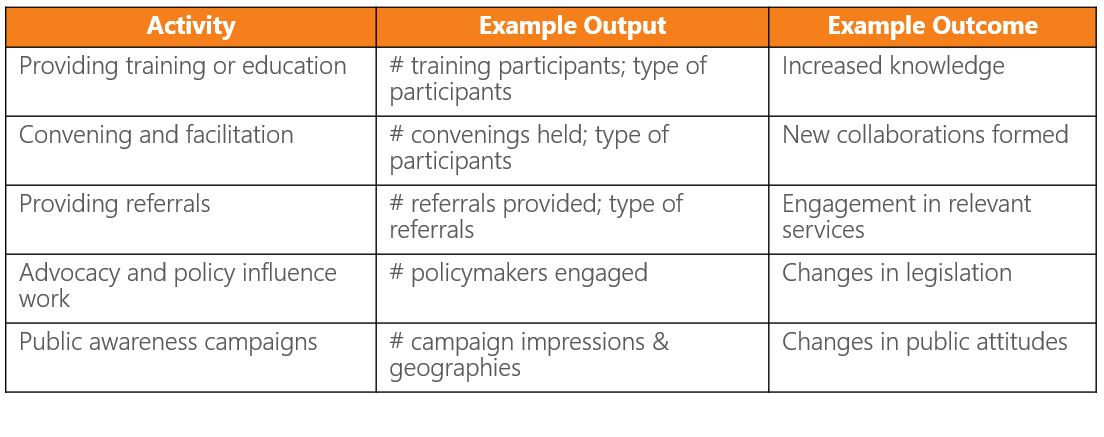Crafting a Theory of Change, Part 2: Finalizing and Testing
5/20/24 / Paul Collier

A strong Theory of Change (ToC) expressed in writing is a critical aspect of any social mission organization’s strategy. Building on our first blog on this topic, here we outline how to complete your organizations ToC.
Defining Activities, Outputs, and Outcomes
With your organization’s target population(s) and problems-to-solve clearly defined, the next step is to outline your organization’s intended outcomes and the activities (or services) offered to arrive at these outcomes.
- Outcomes are the directional changes in knowledge, skills, attitudes, aspirations, behaviors, or conditions, that your organization is hoping to influence among your population.
- Activities are the concrete things your organization does (or intends to do) with your population to make those changes a reality.
- Outputs are quantifiable indicators of engagement with activities.
It is important to measure both outputs and outcomes to have a complete understanding of your success at making an impact – just participating with your organization does not mean that someone’s life has been changed. Here are a few examples of activities and their corresponding outputs and outcomes:

We suggest beginning by getting on the same page about your long-term outcomes, or the most distant changes you hope to help your population achieve. These may take many years to become a reality and can take the form of system changes, cultural shifts, or a change in status for an individual or group. Long term outcomes are often the inverse of your problem statement.
Once you have identified your long-term outcomes, you can work backwards to define shorter-term outcomes that are preconditions for those longer-term changes. Short term outcomes are most proximate changes that are either observable immediately after an activity occurs, or shortly thereafter. These will often include feelings of satisfaction or trust, and changes in knowledge, skills, attitudes, or aspirations.
Visualizing your Theory of Change
With your organization’s target population, problem-to-solve, outcomes, and activities defined, it’s time to start thinking about how you might visualize your ToC. First, it’s important to consider who your audiences are for your Theory of Change, and what format (i.e., webpage, presentation, printed one-pager, etc.) works well for them.
Then, you can seek inspiration from other theories of change. A short Google Image search for “Theory of change for [your organization type]” will reveal some starting points, as will this article from Venngage on how to visualize a ToC. If your organization has the ability to work with a graphic designer on this step, doing so can save you and your team a considerable amount of time.
Identifying Inputs and Assumptions
With the rest of the elements of your organization’s ToC defined, there are two final elements to add: Inputs and Assumptions.
Inputs are the assets and resources your organization brings to bear to enable your activities, and include the financial resources, people (staff and volunteers), expertise, technology systems, data, and other intangibles like community trust and brand positioning that enable your team to work effectively. It is often not possible to list all resources in detail. Rather, your goal is to communicate what your organization has (or needs to have) to successfully produce an impact, and what assets uniquely position your organization to make an impact.
Assumptions are inherent in any ToC. With the rest of your ToC written out, you can step back and ask yourself “what assumptions are we making about how change happens here?” Most organizations do not share these assumptions outside of their team. That said, the most strategic organizations can honestly identify their assumptions, identify those that pose the greatest risk to them making their intended impact, and create plans to monitor or mitigate those risks.
Testing, Tips and Tricks
Before finalizing your organization’s ToC, we always recommend testing your work by getting feedback from 3 – 5 people who were not involved in the drafting process. Getting additional feedback helps strengthen your analysis, allows you to practice using your ToC as a communications tool, and is generally a good opportunity to reconnect with your network. We suggest asking “friendlies” first – those who know your issue and are strongly connected to your organization. This might include certain board members, foundation program officers, highly engaged volunteers or program participants, or leaders at peer organizations. Ask them:
- Is our Theory of Change clear as we have expressed it?
- Is our Theory of Change plausible? Or are there components that seem missing?
- Is our Theory of Change authentic – it expresses what we do well and aligns with our values as an organization?
As you come to the close of your drafting process, it’s important to realize a ToC is never “done” or “right.” It represents a hypothesis — your best guess about how your activities lead to specific, meaningful outcomes for a particular group of people. This best guess should be updated once every year or two as your team learns from experience.
When you have a final draft of your ToC, be sure to celebrate your team’s accomplishment! Now you can plan to make the most of this asset. Three of our favorite ways do this include:
- Using it to tell your organization’s impact story to staff, funders, and partners.
- Using it as a framework for making decisions about how to allocate time and money.
- Testing it by collecting qualitative / quantitative data to support or refute your theory.
If you’d like to talk in more depth about the nuances of creating a cohesive, actionable Theory of Change for your organization, just contact us.
